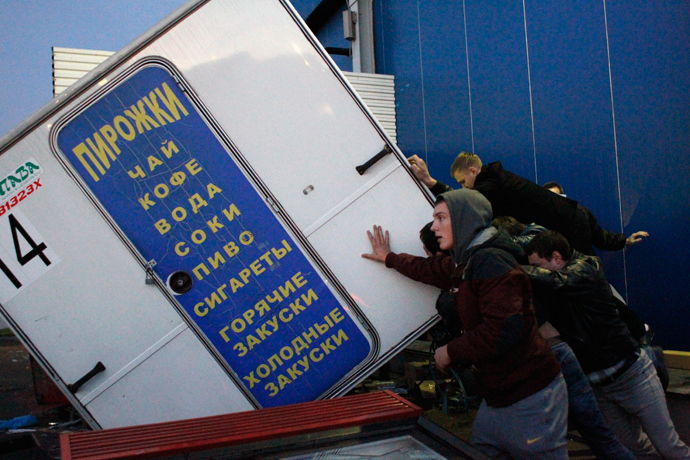
Race Riots and Extremist Demonstrations Occur With Increasing Frequency in Russia
Publication: Eurasia Daily Monitor Volume: 11 Issue: 42
By:

According to Moscow’s SOVA Center for Information and Analysis, radical Russian nationalists tried to arrange several more skhods (translated as “people’s gatherings”—generally involving street marches and demonstrations) in January 2014, as the country was preparing to host the Winter Olympics in Sochi (https://www.sova-center.ru/racism-xenophobia/publications/2014/01/d28925/). In the past, such gatherings of extremists permutated into race riots by ethnic Russians against people from the Caucasus and Central Asia. The first prototypical provocation of such riots occurred in the Karelian town of Kondopoga in August 2006, and since then, the technique has become a regular tactic of the Russian far right. Riots in Stavropol (2007), Sagra (Sverdlovsk Oblast—2011), and Pugachyov (Saratov Oblast—2013) had all broken out after a skhod was held by radical extremist groups in the respective cities (https://jamestownfoundation.blogspot.com/2013/07/pugachyov-and-kondopoga-technology.html). The most recent “successful” mass race riot occurred in the Moscow suburb of Biryulyovo in October 2013. Recent events demonstrate that the far right plans to keep trying to provoke such riots.
The first such potentially volatile street demonstration this year came on January 11, when nationalists arranged a skhod in Astrakhan (a city of 500,000, situated at the mouth of the Volga River) to mourn the death of 23-year-old ethnic Russian Gailya Borisenko. Borisenko had gone missing in summer 2013, re-appeared on January 1, 2014, and committed suicide shortly afterwards (https://www.kp.ru/daily/26180.5/3069949/). Borisenko had allegedly been kidnapped by a Dagestani man, and some reports claim that the people’s gathering was intended to seek further information about her death. Presumably, at least some of the march participants believed there was a connection between Borisenko’s treatment by her captor and her suicide. An estimated 150 people participated in the march (https://ast-news.ru/node/12630), demonstrating the sensitivity around ethnic issues in Russia. Videos of the march show a heavy Russian police presence, suggesting the authorities’ awareness of how easily such a situation could spiral out of control (https://www.youtube.com/watch?v=S1ZnVwsEklg).
Other similar actions took place in the country’s capital. On January 25 there was another gathering in the working-class suburb of Biryulyovo—itself the scene of vicious pogroms against Caucasian and Central Asian guest workers last October. The January 2014 gathering was held in response to the murder of pregnant 17-year-old Anastasia Moskovkina, purportedly by a person of “non-Slavic” appearance. Moskovkina was found on January 20, in the doorway of an apartment in eastern Biryulyovo. There were signs she had been sexually violated and her body was marked by extreme mutilation (https://www.newizv.ru/lenta/2014-01-23/195904-zhutkie-podrobnosti-ubijstva-v-birjulevo-pered-smertju-devushku-pytali.html). The skhod that followed drew between 100 and 150 people, and there were dozens of arrests. Nationalists praised the skhod for causing the authorities to re-open the case into Moskovkina’s death (https://ru-nsn.livejournal.com/4076447.html). If more people had shown up to participate in the January 25 march, the police may have been unable to prevent a repetition of the events of October 2013. Likewise, nationalist groups organized a skhod on January 15, in the Moscow suburb of Novokosino, which was advertised on far-right websites, and which resulted in the arrest of a number of demonstrators. The area had seen a series of clashes in November 2013 against the proposed construction of hostels for migrant workers (https://echo.msk.ru/news/1238438-echo.html). These two examples demonstrate both how such “people’s gatherings” and protests are becoming a commonly-used weapon in the nationalist arsenal and that such tensions are repeatedly manifest in the same places.
Yet another skhod took place in St. Petersburg on January 31. The gathering took place outside an apartment building located on Citizens’ Prospect—the location of an earlier assault on two Russian pensioners. The gathering specifically targeted Central Asian migrants, who were accused of attacking the two elderly people on their way back from the post office. The participants in the gathering were mostly from nationalist organizations and the supporters’ club of the “Zenit” soccer team. The city authorities were quick to police the meeting; reports say that six truckloads of police officers were present (https://www.newsru.com/russia/01feb2014/pitershod.html). This latest St. Petersburg skhod came after a march “against ethnic criminals” in the city on the December 14, 2013 (https://www.youtube.com/watch?v=K-2F4SA_CAY). Video footage of that demonstration shows marchers crying “Russian power for Russia” and accusing the authorities of complicity with ethnically non-Russian criminals. The inherent danger, as always, is that such cases become a cause celebre for the Russian far right, which next time attract more participants than can be policed safely.
While ethnically driven nationalism has been an often-noted feature of Russian politics in the past few years, the scale, frequency, and rapidity with which extremist nationalists are organizing such volatile “people’s gatherings” is truly alarming. Years elapsed between the first successful use of such popular agitation in Kondopoga in 2006 and its most successful use to date on Manezhnaya Square in 2010. It is, thus, tempting to conclude that the nationalist movement is gathering momentum in Russia and is emerging as the main opposition force to the government. Indeed, Emil Pain of the Institute for Ethnography and Anthropology recently released an article arguing that such “people’s gatherings” and the far-right in general have replaced regular political protest in the Russian Federation. He has further argued that the skhods’ ascendancy was partly being driven by the fact that the Kremlin appears to be far more comfortable with ethno-nationalist demonstrations than with political protests (https://magazines.russ.ru/druzhba/2014/1/18p.html). If so, the Kremlin is playing a very dangerous game to deflect public anger: Should such events snowball—one getting out of hand anywhere in Russia and encouraging copycat demonstrations—or arouse serious anger in the non-ethnic-Russian republics, then the consequences for the integrity of the Russian state could be dramatic.




